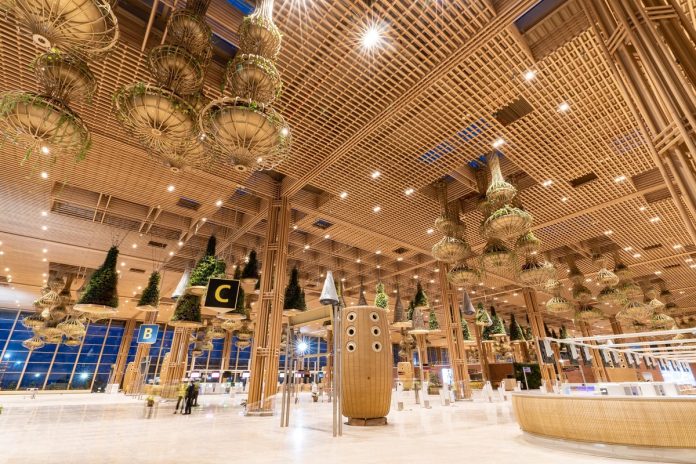Snapshot
-
The terminal is set to offer an unique outdoor experience for arriving and departing passengers.
Passageways throughout the terminal will connect the passengers with nature, as it features trees, small gardens and ponds with local species of plants.
By mid-January, the new terminal T-2 of the Bengaluru International Airport Ltd (BIAL), in Bengaluru is anticipated to begin operations.
Terminal-2 of Kempegowda International Airport at Bengaluru was built at a cost of around Rs 5,000 crore.
T-2 is spread across a built-up area of 255,661 sqm, with a capacity of handling 25 million passengers every year. The terminal houses 90 check-in counters, 34 self-bag drop counters, 40 self-service check-in kiosks, and a baggage handling system equipped to handle 4,500 bags every hour.
During the second phase, the terminal will be expanded by another 4.41 lakh sqm.
About 95 per cent of the work has been completed, and the airport’s administration is currently working to enhance the passenger experience.
A five-lane road is being built to facilitate easier vehicle arrivals and departures for pick-up and delivery of passengers at the airport.
Beginning in April, the terminal is expected to undertake international operations.
“Currently, our teams are conducting a drill to handle 5,000 bags at a time in the new terminal. The work is the final phase and by mid of January, the operations will begin at Terminal 2,” said a senior official, reports Hindustan Times.
The new terminal was initially supposed to start operations by the end of this month, but that deadline was postponed.
T-2 was formally launched by Prime Minister Modi on 11 November and is being called a ‘Terminal in a garden’.
An ode to the legacy and history of Bengaluru, it reflects new-age philosophies of sustainability and renewable energy, the use of future technologies and a maniacal commitment to the city’s historic tag of being “the garden city” of India.
In Oct 2018, Bengaluru International Airport (BIAL) awarded the contract to L&T’s Buildings & Factories business for the construction of the T-2. The contract includes design, procurement, engineering, construction, testing and operations of Terminal-2.
American architectural firm Skidmore, Owings & Merrill (SOM) was selected for providing the design of the terminal. It chose a design for the terminal to reflect the ethos of Bengaluru as a garden city.
Billed as the garden terminal, it features trees, small gardens and ponds with local species of plants.
Passageways throughout the terminal will connect the passengers with nature. The ceiling at the entrance, check-in and security area will feature hanging planted bells.
The new terminal will also feature a large indoor garden with rammed-earth walls and waterfalls, which will act as a gateway into the densely-landscaped retail area.


The three-storeyed forest belt is set to offer an unique outdoor experience for arriving and departing passengers. It will be well connected to the shopping area. The forest belt will be viewable from all main indoor spaces.
Among other things, T-2 will include a multi-level car parking area and a lagoon for water recycling, apart from a multi-modal transport hub aligned to the main entrance, to which a metro station built by Namma Metro will offer connectivity to and from Bengaluru city.


